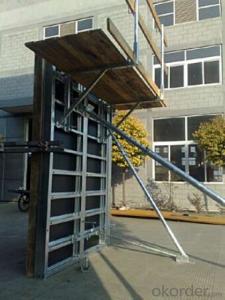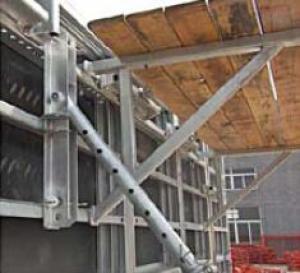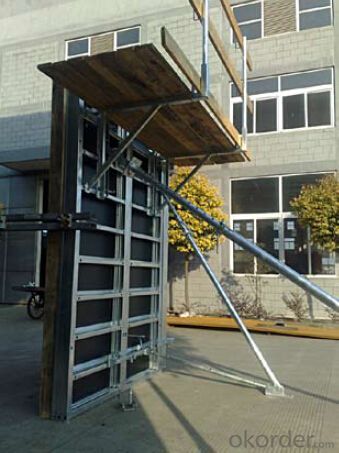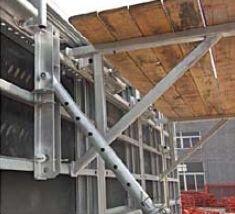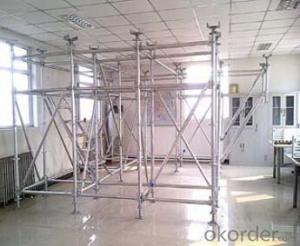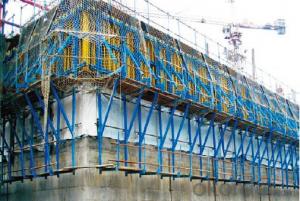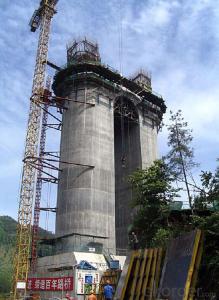Steel Frame Working Platformfor Formwork and Scaffolding system
- Loading Port:
- Tianjin
- Payment Terms:
- TT OR LC
- Min Order Qty:
- 50 m²
- Supply Capability:
- 1000 m²/month
OKorder Service Pledge
OKorder Financial Service
You Might Also Like
Steel-frame Formwork SF-140
Characteristics:
◆ Few parts for fast forming.
◆ Max. Concrete pressure: 80KN/m2.
◆ Hot-dip galvanized steel frame.
◆ The thickness of plywood is 18mm & the panel is 14cm.
◆ Compatibility with Hunnebeck Manto system due to similar edge profile.
System Details & Application:
◆ Neat joint and fast assembling with aligning panel clamp.
◆ Flexible panel arrangement and height extension.
◆ The selection of panels.
◆ Kinds of panel connectors.
◆ Corner clamp application.
◆ Length adjustment application.
◆ Height adjustment & aligning strut.
◆ Walkway bracket & platform.
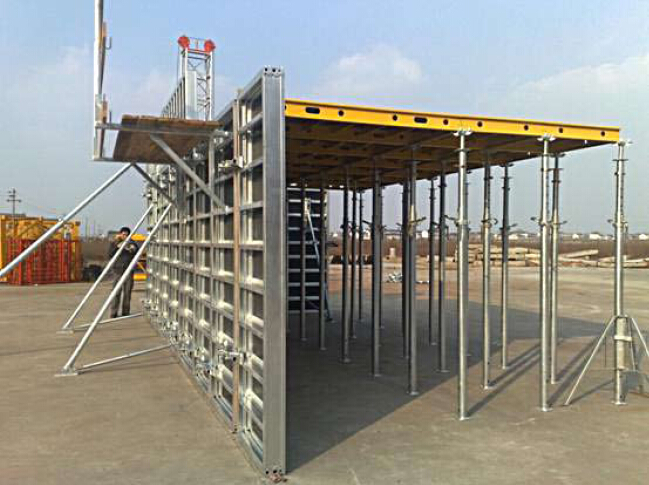
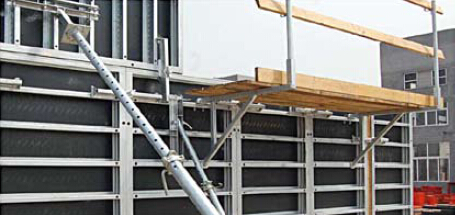
- Q: What are the common design considerations for steel formwork?
- Some common design considerations for steel formwork include the strength and stability of the structure, ease of assembly and disassembly, dimensional accuracy, resistance to deformation or warping, durability against repeated use, compatibility with other construction materials, and ability to accommodate various concrete mix designs and pouring techniques. Additionally, factors such as cost-effectiveness, safety, and environmental impact are also taken into account during the design process.
- Q: How does steel formwork affect the overall construction site safety?
- Steel formwork can significantly enhance overall construction site safety. Its strength and durability ensure stability and structural integrity during concrete pouring and curing processes. The use of steel formwork reduces the risk of formwork collapse or failure, which can cause serious accidents and injuries. Additionally, steel formwork's fire-resistant properties provide an added layer of safety, minimizing the potential for fire-related incidents. Overall, steel formwork promotes a safer construction site by reducing potential hazards and enhancing the structural stability of the project.
- Q: How does steel formwork handle different concrete surface preparation techniques?
- Steel formwork is highly versatile and can handle various concrete surface preparation techniques with ease. Whether the concrete surface needs to be smooth, textured, or have specific patterns, steel formwork can accommodate all these requirements. It provides a strong and stable framework to hold the concrete in place during pouring and curing, ensuring that the desired surface finish is achieved. Additionally, steel formwork allows for easy demolding and reusability, making it a preferred choice for construction projects requiring different concrete surface preparation techniques.
- Q: Can steel formwork be used in precast concrete applications?
- Yes, steel formwork can be used in precast concrete applications. Steel is a versatile and durable material that can withstand the pressures and forces exerted during the precasting process. It provides excellent support and stability to the concrete during pouring and curing. Steel formwork also allows for precise shaping and detailing of the concrete elements, ensuring accurate dimensions and a high-quality finish. Additionally, steel formwork can be easily assembled and disassembled, making it a suitable choice for repetitive and fast-paced precast production. Overall, steel formwork is widely used in precast concrete applications due to its strength, versatility, and ease of use.
- Q: How is steel formwork different from other types of formwork?
- Steel formwork is different from other types of formwork primarily because it is made of steel, which provides superior durability, strength, and stability. Unlike traditional wooden formwork, steel formwork is reusable, ensuring cost-effectiveness and reduced waste. It is also highly adaptable, allowing for customization and flexibility in construction projects. Additionally, steel formwork offers a smooth surface finish, leading to enhanced quality and aesthetics of the final structure.
- Q: How does steel formwork affect the overall accuracy of concrete structures?
- Steel formwork can greatly improve the overall accuracy of concrete structures. Its rigid and sturdy nature ensures that the concrete is properly shaped and aligned, resulting in precise dimensions and smooth finishes. Steel formwork also helps in minimizing any deformations or imperfections during the curing process, leading to a more accurate and aesthetically pleasing final product. Additionally, the use of steel formwork allows for efficient construction, reducing the risk of errors and ensuring the structural integrity of the concrete structures.
- Q: Can steel formwork be used for both interior and exterior concrete placement?
- Yes, steel formwork can be used for both interior and exterior concrete placement. Steel formwork is versatile and durable, making it suitable for a wide range of construction projects, including both indoor and outdoor applications.
- Q: What are the different sizes and dimensions available for steel formwork panels?
- Steel formwork panels are available in various sizes and dimensions to suit different construction needs. The most common sizes for steel formwork panels are 1.2 meters by 2.4 meters and 1.5 meters by 3 meters. These sizes are widely used in the construction industry due to their versatility and efficiency. The thickness of steel formwork panels can vary depending on the required load-bearing capacity and durability. Typically, steel formwork panels range from 12mm to 18mm in thickness. Thicker panels are often preferred for heavy-duty applications, while thinner panels are suitable for lighter loads. In addition to the standard sizes, custom sizes and dimensions can also be manufactured to meet specific project requirements. This flexibility allows contractors to tailor the formwork panels to their unique construction needs, ensuring optimal performance and efficiency on the job site. It is important to note that the sizes and dimensions of steel formwork panels may vary between manufacturers. Therefore, it is essential to consult with the supplier or manufacturer to determine the available sizes and dimensions for a specific product line. This will ensure that the chosen steel formwork panels are suitable for the intended application and meet the necessary structural requirements.
- Q: How does steel formwork contribute to the overall thermal insulation of the building?
- Steel formwork does not directly contribute to the thermal insulation of a building. Instead, it is used as a temporary structure for creating the desired shape and structure of concrete elements. The thermal insulation of a building is typically achieved through the use of insulation materials, such as foam boards or mineral wool, which are installed within the walls, floors, and roofs.
- Q: How does steel formwork compare to timber formwork in terms of cost?
- Compared to timber formwork, steel formwork tends to have higher upfront costs. This is mainly because steel is more expensive than timber. In addition, steel formwork often requires specialized equipment and skilled labor for assembly and disassembly, which can increase the overall cost. However, it is crucial to consider the long-term advantages and cost-effectiveness of steel formwork. Although timber formwork may have a lower initial cost, it is more prone to damage, especially in harsh weather conditions or with repeated use. On the other hand, steel formwork is highly durable and can be used for multiple construction projects, making it a cost-effective choice in the long run. Furthermore, steel formwork provides greater precision and accuracy, resulting in better quality finishes and less rework. It also allows for faster construction due to its easy assembly and disassembly, which can lead to significant time and labor savings, ultimately offsetting the higher upfront cost. To summarize, although steel formwork may be initially more expensive, it offers durability, reusability, and increased productivity, making it a more cost-effective option in the long term compared to timber formwork.
Send your message to us
Steel Frame Working Platformfor Formwork and Scaffolding system
- Loading Port:
- Tianjin
- Payment Terms:
- TT OR LC
- Min Order Qty:
- 50 m²
- Supply Capability:
- 1000 m²/month
OKorder Service Pledge
OKorder Financial Service
Similar products
Hot products
Hot Searches
Related keywords
